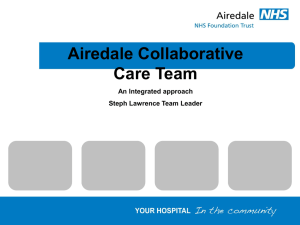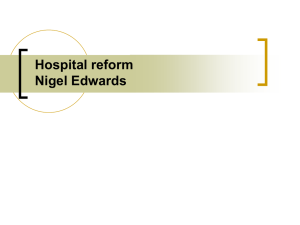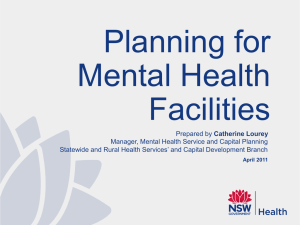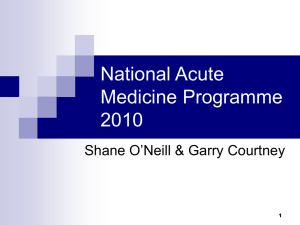Joint Committee on Health and Children Meeting Thursday 15th
advertisement
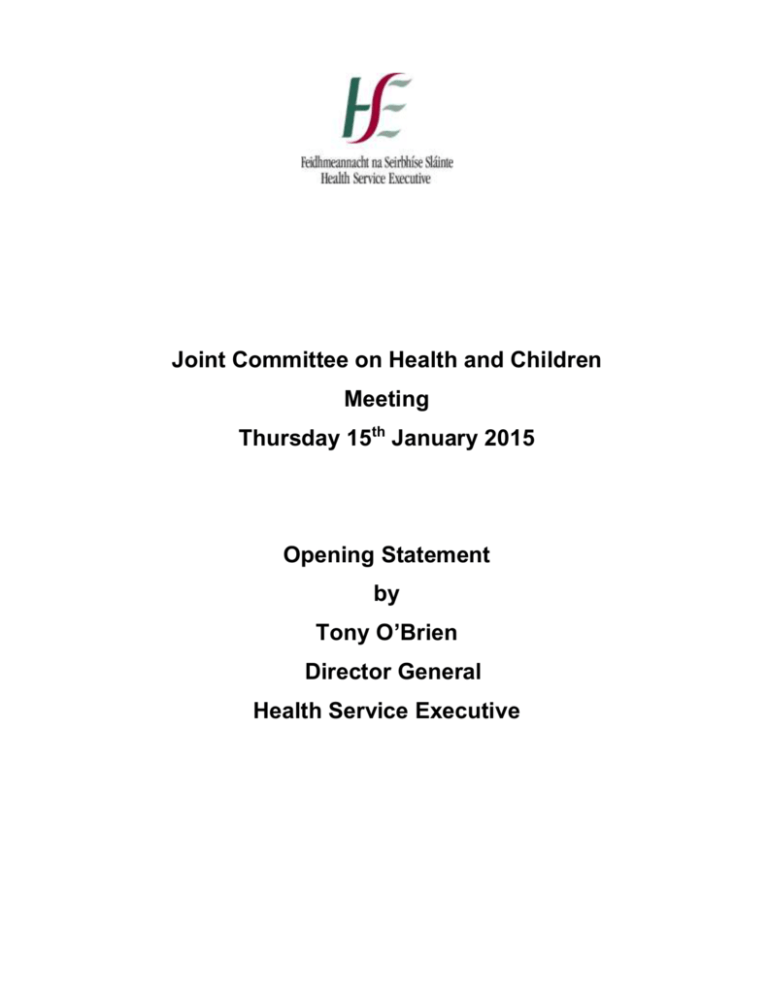
Joint Committee on Health and Children Meeting Thursday 15th January 2015 Opening Statement by Tony O’Brien Director General Health Service Executive Good afternoon Chairman and members of the Committee. Thank you for the invitation to attend the Committee meeting this afternoon. I am joined today by: Pat Healy, National Director Social Care Angela Fitzgerald, Deputy National Director, Acute Hospitals Division Dr. Colm Henry, National Clinical Advisor & Programme Lead for Acute Hospitals 1. Introduction The pressures on EDs experienced over the past two weeks are not new or unexpected. As I have highlighted previously to this Committee, the over 65 population is growing by approximately 20,000 per year and those over 80 by 4% annually. Due to reduced budgets over the past number of years, the development of the required capacity within our community services to deliver Home Helps, Home Care Packages, short stay and long stay residential care has not kept pace with this demographic growth. Furthermore, acute hospitals have experienced increased presentations and avoidable admissions, increased numbers of delayed discharges and unacceptable numbers of patient’s on trolleys in their emergency departments. The data informs us that the numbers of emergency presentations in 2014 is up 2% on 2013 and emergency admissions are up 1.8% on 2013 levels. The main factor leading to the current ED pressures relates to higher numbers of delayed discharges in acute hospital beds, when comparing this year to same period last year. On the 6th of January there were 770 delayed discharges reported across the acute hospital services. This was approximately 150 more than at this time last year and this has led to a consequent increase in the numbers of patients on trolleys requiring admission particularly on the first week of the year. 2 2 This was despite both the hospital and community investing in transitional care beds during the course of 2014. 2. Measures Implemented to Address Winter Surge Hospital Escalation Measures Winter planning is an embedded response within acute hospitals and community services. In order to manage increased demands Hospitals have been required to be at a state of escalation since Autumn 2014. This is part of the normal planning in place to deal with the expected surge in demand in EDs where Hospitals invoke escalation plans which includes the opening of additional overflow areas, curtailing non emergency surgery, providing additional diagnostics and working in an integrated way with their community service colleagues in strengthening discharge planning. Hospitals have continued to take these steps, since September 2014 as required, so that patients who need to be admitted to hospital are admitted to a bed as soon as possible. In readiness for the demands of the winter period, during the month of December the acute hospital system cancelled non-urgent elective activity to ensure maximum capacity was available to deal with emergency admissions. Primary and Social Care services in particular escalated their plans to facilitate discharges through the provision of home care, aids and appliances, access to community hospital beds where available etc. In addition, the Minister for Health convened the Emergency Task Force which supported the measures being undertaken by the hospital and community services to prepare for the anticipated additional demand for services during the key period post Christmas. 3 Additional Resources Recognising the increase in delayed discharges and the fact that sufficient funding has not been available for the past 6 years during the recessionary period, the Minister has managed to secure a total of €25m as part of the Service Plan for delayed discharge patients in 2015. Preparatory work for its implementation commenced in November 2014 and additional resources were allocated for Delayed Discharges in December. This funding came on stream on January 1st of 2015 €3m in December NHSS As delayed discharge figures reached their highest level by the end of November 2014, as an interim measure prior to the 25m coming on stream, an additional allocation of €3m was provided in December to enable the early release of the additional 300 Fair Deal approvals immediately. This was in addition to the regular release of 700 places, bringing the overall allocation to 1,000 places for the full month of December, 2014. Transitional Care Beds Also in December, 165 additional transitional care beds were funded and targeted at hospitals in the greater Dublin area to facilitate speedy discharges. Home Care and Home Supports Additional Home supports were provided with a specific focus on supporting acute hospital discharge prior to the Christmas period. In fact during Christmas week 120 Home Care Packages were provided in total, with 87 related to patients in the acute hospitals. The combined efforts of the above initiatives saw a net reduction of 109 delayed discharge patients with approx 700 Delayed Discharges reported at the end of December 2014. 4 4 2015 Service Plan €25m Package-Further detail in relation to the additional funding The full €25m package is being implemented since January this year as follows: Nursing Home Support Scheme €10m This additional resource will support in a full year the 300 extra places allocated under the scheme in December 2014. This has had the impact of reducing the placement list to 1,160 on the first week in January and reducing the funding for Fair Deal from 15 weeks to the current 11 weeks. Short-Stay Residential care €8m This is being used to provide an additional 115 short stay beds. • 50 of these short-stay beds have been earmarked for provision in private nursing homes for the greater Dublin area. • The remaining 65 beds will be open in Mount Carmel on a phased basis commencing March / April 2015 as a dedicated community hospital for Dublin. Home Care Packages (HCPs) €5m This will provide 400 additional HCPs benefiting 600 discharges across targeted Dublin hospitals during the course of the year, to facilitate patients to return to their own homes in the community. Community Intervention Teams (CITs) €2m. The CIT Service is expanding its service levels in the greater Dublin region and will deliver services to an additional 8,000 CIT patient cases. In addition new CIT services are being established in Kildare, Louth and Waterford servicing the main hospitals in these regions and providing direct access to GPs and Nursing Homes thereby facilitating patients having to attend hospital unnecessarily. 5 3. Additional Measures In response to the continuing pressures in our ED departments, all of the focus of our efforts during the month of January, has been to maximise the discharge of patients from our acute hospitals who have completed their acute treatment either to home with home care supports where required or to more appropriate residential care. To achieve this we have sought to eliminate “red tape” as much as possible and during the month of January, as an exceptional measure, all patients who are clinically discharged, but who require ongoing levels of residential care are being matched with suitable nursing home placements following clinical review. This will see a potential movement of 250 patients who are currently in acute hospitals to other suitable facilities, While much of my previous commentary has focused on delayed discharge as a factor, it is important to note that there are 28 emergency departments in Ireland and the challenges faced vary between each location:For example, in Beaumont where there has been a persistent level of delayed discharges and number of people on trolleys, there is a direct relationship with the shortage of residential capacity in North Dublin. However in Letterkenny for example, where over the weekend of the 3rd- 5th January, 2015, there were over 31 people on trolleys, the problem was not related to delayed discharges but rather related to a particular spike in the number of unwell elderly presenting at the hospital Another example is St. Luke’s Kilkenny which is a level 3 hospital with a very good reputation for integrated working across hospital and community and for maintaining low levels of delayed discharges and trolley waits and on Monday January 5th there were 22 patients on trolleys 6 6 4. What Has Worked Well The current mainstream and integrated efforts at National level are enabling a cohesive and consistent response to cope with the demands. In addition:• The leadership role of Clinical Directors, consultants and nursing management in carrying out additional ward rounds and discharge planning is proving effective in alleviating the pressures in ED. • The role of primary care and social care in:• extending CIT coverage, facilitates early discharge or hospital avoidance where possible, also • the use of public beds to decant patients from acute hospitals has contributed significantly in dealing with demand issues. • Early release of NHSS funding arrangements in December, coupled with the provision of additional Transitional Care Beds and additional Home Care Packages allowed discharge to continue throughout the month of December and the crucial Christmas period, and at this point no one on the delayed discharge list is waiting for HCP funding • Collaboration across hospitals in terms of enabling bed access has also assisted in reducing the delayed discharges e.g. • Rehab beds in Cappagh for Connolly and Drogheda • Use of elective beds in Navan for Drogheda • Optimisation of Model 2 hospitals – Ennis, Nenagh, Bantry & Mallow supported wait times for limerick and the South West • The ongoing escalation of matching patients, (250), who are medically discharged with nursing home care placements, is proving beneficial in yielding capacity. 7 5. Deficits in service There are recognised deficits in key service areas which support the discharge process particularly of older people:• Home Help: the level of HH service has reduced significantly over the past number of years from €211m to €185m currently. • HCP: The funding available for HCPs has remained relevantly static since 2008. • Public Residential care beds are key component of service provision and must be retained at existing levels despite the impending issues with compliance on infrastructure. • Reliance on agency, medical and nursing, due to market conditions, together with associated challenges in terms of recruiting and retaining senior decision makers, is impacting on the ability open additional capacity 6. Summary Section The outcome of the review of the NHSS, currently being undertaken by the DOH, will need to provide longer term solutions to place the scheme on a sustainable footing, recognising the demand led nature of the scheme and an ageing population. The development of the required capacity across primary and social care is essential to meet the demographic growth in a predominantly elderly population. The challenge for re-registration of public long-stay beds with HIQA is a significant issue to be dealt with over the coming months as there is insufficient capital funding available to meet all the requirements and there are over 30 large units who provide in excess of 2,500 beds and where there is, currently, insufficient funding in the capital plan to bring this infrastructure to the required standard. 8 8 I would like to take this opportunity to acknowledge the discomfort and in many cases stress caused to patients and those who have experienced our EDs over the past period of time and to reassure them that we are doing everything we possibly can to deal with the situation. I would also like to thank all the staff, nurse’s, doctors and others, in these services for their diligence, patience and hard work amidst such difficult circumstances. This concludes my statement and I have added some additional notes as information for the members. Together with my colleagues we will be happy to take any questions. Thanks you. 9 Additional Speaking Notes: Deficits in service There are recognised deficits in key service areas which support the discharge process particularly of older people:• Home Help: the level of HH service has reduced from a high of 11.98m hours delivered to 55,000 people in 2008, to a current level of 10.3m hours delivered to 47,000 people, showing a reduction of 14% being supported by the service. The funding level was reduced from a high of €211m to €185m over this period. • HCP: While the numbers being supported by HCP have increased year on year to the current position of 13,057, the average value of each HCP has fallen as the funding available has remained relatively static since 2008. • Public Residential care beds are key resources in the continuum of care, as short-stay beds serve as an intermediate care provision across hospital and community providing respite, assessment and step-down care. There is a necessity to maintain the bed stock availability in the public system and this will be a challenge given the requirements for improved infrastructure under the regulations as inspected by HIQA over the coming months. • Reliance on agency, medical and nursing, due to market conditions, together with associated challenges in terms of recruiting and retaining senior decision makers, is impacting on the ability open additional capacity Ends 10 1 0

